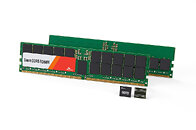TheLostSwede
News Editor
- Joined
- Nov 11, 2004
- Messages
- 18,434 (2.47/day)
- Location
- Sweden
| System Name | Overlord Mk MLI |
|---|---|
| Processor | AMD Ryzen 7 7800X3D |
| Motherboard | Gigabyte X670E Aorus Master |
| Cooling | Noctua NH-D15 SE with offsets |
| Memory | 32GB Team T-Create Expert DDR5 6000 MHz @ CL30-34-34-68 |
| Video Card(s) | Gainward GeForce RTX 4080 Phantom GS |
| Storage | 1TB Solidigm P44 Pro, 2 TB Corsair MP600 Pro, 2TB Kingston KC3000 |
| Display(s) | Acer XV272K LVbmiipruzx 4K@160Hz |
| Case | Fractal Design Torrent Compact |
| Audio Device(s) | Corsair Virtuoso SE |
| Power Supply | be quiet! Pure Power 12 M 850 W |
| Mouse | Logitech G502 Lightspeed |
| Keyboard | Corsair K70 Max |
| Software | Windows 10 Pro |
| Benchmark Scores | https://valid.x86.fr/yfsd9w |
Although DRAM is using much less refined production processes compared to the latest processors and GPUs, all the major manufacturers are continuing to shrink their manufacturing nodes step by step. Part of the reason for this, is that a node shrink doesn't have the same improvements for DRAM as it does for most types of field-effect transistors or FETs, which are mostly used for making processor logic of some kind. SK Hynix is now said to have entered the partner verification process of its 5th gen 1β DRAM, to make sure its latest 1x nm DRAM is compatible with major applications. In SK Hynix's case this should roughly translate to a 12 nm process node.
According to Chosun Media in Korea, Intel will take part in this verification, with Intel having finished verification of SK Hynix's 4th gen 1α DRAM for its 4th gen Xeon Scalable processor. Initially, SK Hynix's 5th gen 1β DRAM will be targeting server applications, so it's likely it will be tested for compatibility with the same platforms from Intel, among others. The new 1β DRAM is said to increase efficiency by more than 40 percent, although the publication didn't mention if this is power efficiency or something else. The 1β DRAM from SK Hynix, as well as Samsung—who announced its 1β DRAM in December 2022—are made using an EUV lithography process and the two Korean DRAM makers are the only two makers of DRAM that are using EUV so far.

View at TechPowerUp Main Site | Source
According to Chosun Media in Korea, Intel will take part in this verification, with Intel having finished verification of SK Hynix's 4th gen 1α DRAM for its 4th gen Xeon Scalable processor. Initially, SK Hynix's 5th gen 1β DRAM will be targeting server applications, so it's likely it will be tested for compatibility with the same platforms from Intel, among others. The new 1β DRAM is said to increase efficiency by more than 40 percent, although the publication didn't mention if this is power efficiency or something else. The 1β DRAM from SK Hynix, as well as Samsung—who announced its 1β DRAM in December 2022—are made using an EUV lithography process and the two Korean DRAM makers are the only two makers of DRAM that are using EUV so far.

View at TechPowerUp Main Site | Source



